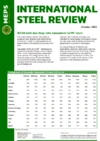Weak Asian demand to limit global steel price recovery
A recovery in global steel prices is likely to be undermined by the ongoing weakness in demand, in China and the wider Asian region.
China, which is responsible for approximately half of steel production worldwide, is suffering from a prolonged period of low market activity. Economic growth is being negatively affected by the authorities’ zero-Covid strategy. Moreover, supply chain difficulties and financial problems in the real estate sector are weighing heavily on consumer confidence.
Domestic hot rolled coil prices, in November, fell to their lowest level since June 2020. The expected seasonal improvement in demand, in September and October, failed to materialise. Policymakers subsequently unveiled a 16-point plan to support the ailing property sector. However, this is not expected to provide any substantial short-term boost to steel prices. Weak trading conditions are likely to persist in China, until the end of the first quarter of 2023.
Chinese steel manufacturers are attempting to sell their excess material to overseas customers. In recent months, Southeast Asian buyers reported that Chinese mills and traders had cut their price quotations. Moreover, producers in China were beneficiaries of the shortage of material, in South Korea, following the supply disruption at POSCO’s Pohang steelworks.
Current trade measures protect the European and North American steel industries from the direct threat of Chinese imports. However, the indirect impact will be felt, as displaced material from East Asia enters both regions.
Steel manufacturers in East Asia are able to source their energy requirements at much cheaper rates than their European counterparts. Moreover, regional output levels are relatively high. MEPS notes little evidence of substantial volumes of steel production capacity being withdrawn.
Inflationary pressures are having a negative effect on several end-user markets. Car production continues to be constrained by the shortage of components. A similar trend is being reported in the white goods sector. Tightening credit controls and labour shortages are hampering activity in the construction industry. Consequently, minimal steel demand growth is anticipated in the coming months.
A degree of restocking, following the Lunar New Year holidays, and the expectation of an upturn in Chinese infrastructure activity, may raise hopes of a demand improvement, in the medium term. However, the potential for any substantial price recovery in East Asia is forecast to be limited, for much of 2023.
As oversupply pressures remain in Asian markets, European and North American steel manufacturers will encounter difficulties in implementing large domestic price hikes next year, due to the continued presence of low-cost alternatives from overseas suppliers.

Source:
International Steel Review
The MEPS International Steel Review is an essential monthly publication, offering professional analysis and insight into carbon steel prices around the world.
Go to productRequest a free publication





